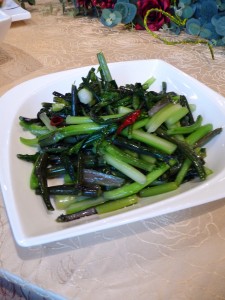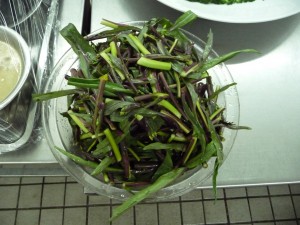In praise of hong cai tai (and other Chinese greens)
I’m back in Changsha, where I lived for a few months while researching my Revolutionary Chinese Cookbook, for the first time in five years. It’s wonderful to see some old friends, including Peng Tieh-cheng, the son of legendary Hunanese chef Peng Chang-kuei (of General Tso’s chicken fame). He’s in Changsha for the same Hunan food conference as me, and I hadn’t seen him for about six years. Peng Tieh-cheng tells me his father, who is now 93, is in good health, and still popping into their main restaurant in Taipei every day.
I’ve had some rather lovely meals in the last 24 hours, and one of the highlights of all of them has been the simplest of dishes: stir-fried red rape shoots (hong cai tai 红èœè‹”), served at lunch with a little dried chilli, and at dinner with slivered ginger. Only the tenderest tips of the shoots are used, and the thicker parts may actually be peeled of their skin. Stir-fried, they have an exquisite flavour and mouthfeel, sweet and juicy, with a hint of dark sleek bitterness in the leaves. Hong cai tai have a similar appeal to asparagus, although I think they are even more delicious. When they are in season, they are served at almost every meal.
‘Seasonal greens’ are often served as an afterthought at Chinese meals, but I think they are one of the glories of Chinese cuisine. In Sichuan, I adore purple amaranth è‹‹èœ stir-fried with garlic, served in its bright pink juices, and water spinach ç©ºå¿ƒèœ wokked with chilli and Sichuan pepper; in Shanghai alfalfa sprouts stir-fried with strong grain spirits è‰å¤´; in Hangzhou tender young greens blanched and then served in a delicate stock; in Hong Kong Chinese broccoli èŠ¥è“ blanched and then sizzled with garlic and rice wine. Cooked well, with a little salt, oil and garlic or ginger, and perhaps a dash of wine and/or stock, they can have an almost buttery deliciousness. And of course they’re very healthy as well.
I wonder if any of you are as addicted to leafy greens as me. In London, I often eat leafy green vegetables, Western or Chinese, and I really miss them if days go by without my fix. Sometimes I’ll cook them in a Western manner, but more often I’ll reach for my wok or steamer, and cook them in one of the many Chinese ways I’ve learnt, because they are so damn good, and also quick and easy.
Any of you like to share your thoughts and cooking tips for your favourite Chinese greens?



16 Responses to “In praise of hong cai tai (and other Chinese greens)”
The flavours and textures of Chinese greens are second to none. I often use a combination of white fermented beancurd, chilli, ginger and garlic for more mineral-rich greens, but similarly I love steam bak choi with a drizzle of oyster sauce.
Shanghai bak choi stir-fried with copious amounts of garlic, a little sesame oil and salt or fermented black beans. But I meet so many Westerners who think it’s got to be a salad to be healthy!
Chinese greens are absolutely a favorite for me as well – I’d go so far as to call myself an addict. They have been the favorite part of my meals in China. The simpler the better – at home I cook with just sesame oil and garlic. In Sichuan province, the peppers – yes, the peppers! (But my daughter won’t go for those at home.)
I fell in love with chinese cooking when I went to China. Greens are definitely so much tastier cooked Chinese style rather than in a Western style. Your post has really made my mouth water.
When in season I can’t get enough of “water spinach” (kong shing chai) stir fried with garlic, salt, and fermented-fish-oil-paste (sa cha). Is there an English term used for this fish-oil-paste “sa cha”?
Jio tsai, Chinese broccoli, pea-shoots… I can’t always tell them apart but for me a Chinese meal – be it dim sum or roast duck noodle soup – just isn’t the same without them. If I cook them at home I try to do them as minimally as possible: stir-fry a little ginger and garlic, toss the greens in the wok, take them off the heat just when they start to look shiny and a bit less raw.
One thing I find odd is that my local Chinese grocery store (in Cambridge, UK) imports these vegetables from China. Not that I’m a real gardener but I would think that they’d grow well in this climate. Maybe I should get the grocery store together with the organic farmers in the area?
I use local (Pacific NW) ingredients to cook chinese style food. With the last of our CSA delivery this year, I made the following –
First I briefly stir-fried apple slices with cracked oats, then added sugar to make a quick caramel sauce. I removed ths from the pan, leaving bits of the sauce and oats. I added a dash of ground chile powder (from home grown and dired lemon drop chiles) curly Kale, sliced thin against the rib and stirfried briefly until almost tender, then added a dash of homemade soy sauce (somewhat lighter than most chinese sauces), added back the apples, tossed, and served.
All in all the goal was to cook chinese food using all local ingredients. It was great.
For anyone who wants to grow their own oriental vegetables I would highly recommend Joy Larkcom’s ‘Oriental Vegetables – The complete guide for the gardening cook’ revised edition published by Frances Lincoln Ltd in 2007
I wonder if you are familiar with a vedgtable called Morning glory leaves? What is it called in chinese? And wich way is the best way to prepare them?
I tasted these in Xiamen in 1996 and remember them as fantastic.
Great idea Emily – good luck with trying to make this happen!
Truis – morning glory is one of the translations for water spinach, known in Chinese by various names, including ‘hollow-heart vegetable’ (kong xin cai 空心èœ), tong cai/tong choy (通èœï¼‰ and weng cai (蕹èœ). You will be able to recognise it by its crisp, hollow, tubular stems. The most common variety sold here in London has long, spearlike leaves.
It is often simply stir-fried with garlic, but it also tastes delicious the Sichuanese way: briefly sizzle a few chillies and a little Sichuan pepper in oil until the chillies are darkening but not burnt, and then add the vegetable (cut into chopstickable lengths) and stir-fry until tender, salting to taste. You can blanch the stems and leaves BRIEFLY in boiling water and drain them well before stir-frying – this will cut the cooking time and reduce the volume, which can be very useful in a domestic wok.
“young greens blanched and then served in a delicate stock”,isn’t it similar to 上汤?
There are too many green vegetables in China, many are regional. What the Shanghainese call è‰å¤´ is also called é‡‘èŠ±èœ (don’t you think it’s fascinating how a vegetable is called differently in different regions of China? The Shanghainese call Chinese Leaf 黄花èœ~~)
To top up your list, there is also pea shoots (豆苗);Basella rubra (紫葛å¶/木耳èœï¼‰which originally was local to 太仓 near è‹å·ž; shephard’s purse (è èœ)ï¼› leafy celery (è¯èŠ¹)ï¼›Chinese leek (éŸèœ)ï¼›Chrysanthemum coronarium(茼蒿èœï¼‰ï¼›mustard green (雪里蕻)……
My sister-in-law said she could eat purely vegetables if she lives in China.
BTW,Fuschia, have you tried stir-frying è•¹èœ with garlic, then finished off with a small dash of Chinese white spirit? let the alcohol evaporate before serving. It’s my favourite way of cooking 蕹èœ.
I do find the ones sold in UK are a bit tough at the stem. Back at home, my Nan would take off the tough stems and stir-fry them seperately with some shredded dried beancurd or preserved mustard (榨èœ), which would turn one vegetable into two dishes. Maybe have a go next time?
fermented mustard green (雪里蕻) with fresh white beancurd strips and edamme beans are delish..
luckily i live in california I can actually find this in alot of tofu shops and some restaurants.
just finsihed reading your “shark’s fin and sichuan pepper” I love the book and read it cover to cover in 2 days. It brings back memories of the delicious food i had in china and taiwan.
豆辦éšï¼Œéº»å©†è±†è…, 宮爆尤éšï¼Œ å°éšä¹¾çµ²ï¼Œ 芹èœç‰›è‚‰çµ²ï¼Œ 竹桶飯,
The book has gotten me thinking about those flavors from childhood and now I can’t stop thinking about them. time for another trip to ranch 99!! (the popular asian market in calif..) lol..
雪里蕻 is amazing cooked well and one of my favorite dishes to order at Hunan restaurants, but the few times I tried cooking it at home it came out tough, shriveled and limp…is there a trick to cooking them that I’m not getting?
豆苗 is also amazing, light, crisp but tender with a nutty sweetness. But again, amazing in restaurants, not so successful at home…
@grace Are there any asian supermarkets in the LA area besides ranch 99? I just moved to LA and am desperately suffering from Chinese food withdrawal! But the nearest ranch 99 is Monterey Park, which is a little too far for my rusty driving skills.
Steph, if you live in LA area, there are 14 locations for 99 Ranch. See http://www.99ranch.com/ Not to mention there are Japanese markets, Korean markets, Vietnamese markets … all those Asian vegetables abound. Happy hunting.
Jay… I found seeds! I know it’s in dutch, but they have pretty much anything and if you have the latin name it’s all you need without the dutch.. http://www.vreeken.nl/2007/index1024x768.php?urloptions=